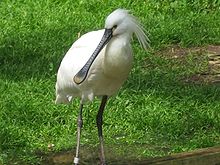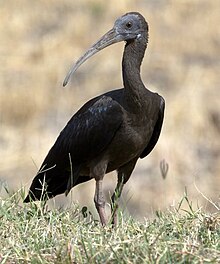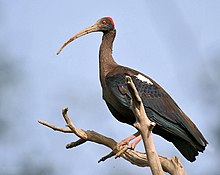Ibises and spoonbills
| Ibises and spoonbills | ||||||||||
|---|---|---|---|---|---|---|---|---|---|---|

Moluccan ibis ( Threskiornis molucca ) |
||||||||||
| Systematics | ||||||||||
|
||||||||||
| Scientific name | ||||||||||
| Threskiornithidae | ||||||||||
| Richmond , 1917 |
The ibises and spoonbills or ibis birds (Threskiornithidae) are a family of the order Pelecaniformes . As the name suggests, the family includes two types of birds that originally formed their own subfamilies: the ibises or ibis and the spoonbills . They are easy to tell apart because they differ in shape. The most noticeable distinguishing feature is the shape of the beak. Spoonbills have a long, conspicuously flattened beak, while ibises have a downward beak.
Spoonbills and ibises are found in tropical and subtropical regions around the world. The spoonbills advance furthest north. The white spoonbill breeds at Lake Neusiedl and in the Netherlands. The northern bald ibis breeded in the Alpine region until the 17th century. There are currently plans to reintroduce the species in Central Europe, Spain and Italy.
features
Ibises and spoonbills are 50 to 110 cm long, have a stocky body, a long neck and long legs. The legs end in an anisodactyl foot with long toes; Webbed skins are only present at the base and can hardly be seen. The wings are long and wide and allow a powerful, fast flight. The long, downwardly curved beak is characteristic of ibises. Spoonbills, on the other hand, have a long, conspicuously flattened beak.
There are white, brown, black and red feathered species. Brown and black colors, however, only occur in the ibis. Apart from the roseate spoonbills, the spoonbills have a white plumage. The dark colored species often have a metallic sheen. In addition, all species have feathered skin areas, mostly on the face. Apart from a slight difference in size, there is no gender dimorphism . However, there is a seasonal change; during the breeding season, the plumage and bare main parts appear more luminous. In some species there is an even more distinct change in color, such as the nipponibis, which is gray in the breeding plumage and white in the dormant plumage.

distribution and habitat
The family is common on all continents except Antarctica. The focus is on the tropics , where the majority of the species are native. There are more species in the Old World than in the New. The Bostrycha species occur in Africa and the offshore islands. The Threskiornes group is distributed in several closely related species from Africa through Asia to Australia. The species of the genus Geronticus , which includes the bald ibis , which was once native to Central Europe, are breeding birds in semi-arid mountain regions.
The typical habitat are lakes or slowly flowing rivers, both in open landscapes and in dense rainforests. However, some species also live in steppes and savannas, the bald ibis even in arid desert climates. In the latter, there is no longer any water binding at all.
The tropical species are resident birds, while the few species in the temperate zones are real migratory birds that overwinter in the subtropics and tropics.
Way of life
activity
Ibises are diurnal birds. They eat during the day and retreat to the trees to rest at night. In contrast, the spoonbills are at least partially nocturnal.
nutrition
The aquatic species eat aquatic insects, insect larvae, small crustaceans and molluscs, and more rarely also small fish and amphibians. The few species that live away from the water in drier areas, on the other hand, feed on grasshoppers, beetles, spiders and snails, and more rarely on lizards, snakes and mice. The ibises use their long beak to insert it into mud and soil and look for something to eat. The spoonbills stir the water and the subsoil by waving their beak to and fro to scare away their food.
Reproduction
Most ibises and spoonbills breed in colonies. They are often mixed colonies inhabited by different species of the family as well as storks, herons and cormorants. The colonies of the genera Threskiornis and Eudocimus , which can comprise several thousand individuals, are particularly large . Only a few species, for example the long-tailed ibis and the cayenne ibis, are rather solitary.
Males arrive first in the colonies and look for a small area that they defend against conspecifics. With the female they enter into a pair bond that either lasts a breeding season or can last for years. For courtship and to a lesser extent later on arrival at the nest, there are a large number of ritualized gestures, such as the lowering of the head, the rubbing of beaks and necks and the exchange of nesting material.
Both partners participate in nest building. Usually the nest is built in a tree and consists of twigs, grass and other plant material. Then the female lays two to five, rarely up to seven eggs. They are white, light green or bluish and always unspotted. Both partners incubate for a period of 20 to 31 days.
When the young birds hatch, they have short, straight bills. This common feature has also been used as evidence of the close relationship between ibises and spoonbills. After just a few days, the beak begins to grow rapidly: in the ibises it becomes long and curved, while in the spoonbills the widening develops. Even at the age of 16 days, a young spoonbill has a beak that resembles that of its parents. The young are fed by sticking their beak deep into the throat of the old animal, which then chokes out the pre-digested food. A special feature is that the young birds do not tolerate salt water; those ibises and spoonbills, which breed in mangroves and usually forage in salt and brackish water, fly inland to find food for their young.
Depending on the species, the young can fledge after 28 to 56 days. Usually no more than two boys get through. Because they hatch unevenly, there are often considerable differences in size in the nest. Smaller siblings have less chance of fighting through feeding and often die prematurely.
The life expectancy of ibises and spoonbills is quite high. Various ibis species have been found to be between 14 and 16 years old in the wild, and one spoonbill lived to be 28 years old.
Duration
Some of the species that make up the ibis and spoonbills are critically endangered. These include the Nipponibis , which used to be found in Japan, China and Korea and now only breeds in a very small area; the bald ibis , whose last natural breeding grounds are in Morocco, the giant ibis , which has already disappeared in parts of its range, the white-shouldered ibis, which is occasionally classified as a subspecies of the warty ibis, and the olive ibis. Among the spoonbills, the black-faced sibi in particular is endangered.
Tribal history
The oldest known representative of the Threskiornithidae is Rhynchaeites messelensis from the Eocene , found in the Messel Pit . Other Eocene birds from China called Minggangia changgouensis and Ibidopsis hordwelliensis may also be Threskiornithidae, although other paleontologists have put them near the railing .
In the Pliocene we already encounter representatives of the recent genera Threskiornis , Geronticus and Plegadis , and fossil remains of recent species are known from the Pleistocene .
Notable ibises of the late Pleistocene and early Holocene are the flightless ibises of Hawaii ( Apteribis ) and Jamaica ( Xenicibis ).
Systematics
For a long time the ibises and spoonbills were placed among the birds. Traditionally, saw them close relatives of the storks, mainly because the stork species of Nimmersatte has many ibisartige features. Today, however, this is mostly seen as a superficial resemblance that says nothing about the relationships. Van Tuinen & al. represented the Threskiornithidae as a sister group of the herons in 2001 , a view that is widely shared today.
Recent genetic analyzes suggest that the ibises and spoonbills, like their sister clade the herons, belong to the pelecaniformes, i.e. are more closely related to the pelicans than to the storks. This classification, which is also used in this article, is also followed by the International Ornithological Union (IOU).
The term Threskiornithidae used here is not undisputed. Since the genus name Platalea is older than Threskiornis , some taxonomists argue that the whole family should be called Plataleidae.
The monophyly of the Threskiornithidae has never been questioned. Originally the family was divided into two subfamilies, the Threskiornithinae (ibises) and the Plataleinae (spoonbills). However, the subfamily Threskiornithinae turned out to be paraphyletic , which meant that the use of the two subfamilies had to be abandoned. Instead, a distinction can be made between two clades within the family, one that occurs only in the New World, consisting of the genera Eudocimus , Phimosus and Theristicus , and one that is distributed almost worldwide with the other genera including the spoonbill. Both lines of evolution separated from one another 39 to 42 million years ago.
species
There are 13 recent genera and over 30 species:
-
Bostrychia
- Hagedasch ( B. hagedash )
- Klunkeribis ( B. carunculata )
- Spotted ibis ( B. rara )
- Guineaibis ( B. olivacea )
- Dwarf olive ibis ( B. bocagei )
-
Cercibis
- Long-tailed ibis ( C. oxycerca )
-
Eudocimus
- Snow ibis ( E. albus )
- Scarlet ibis ( E. ruber )
-
Geronticus
- Waldrapp ( G. eremita )
- Smooth-necked black horse ( G. calvus )
-
Lophotibis
- Crested ibis ( L. cristata )
-
Mesembrinibis
- Green ibis or cayenne ibis ( M. cayennensis )
-
Nipponia
- Nipponibis ( N. nippon )
-
Phimosus
- Black ibis ( P. infuscatus )
- Platalea
-
Plegadis
- Brown ibis ( P. falcinellus )
- White-faced ibis ( P. chihi )
- Narrow-billed ibis ( P. ridgwayi )
-
Pseudibis
- Warty ibis ( P. papillosa )
- White-shouldered ibis ( P. davisoni )
- Giant ibis ( P. gigantea )
-
Theristicus
- Headbandibis ( T. caerulescens )
- White-necked ibis ( T. caudatus )
- Andenibis ( T. branickii )
- Black-rein ibis ( T. melanopis )
-
Threskiornis
- Black- headed ibis ( T. melanocephalus )
- Moluccan ibis ( T. molucca )
- Spiny ibis ( T. spinicollis )
- Sacred ibis ( T. aethiopicus )
- Light-eyed ibis ( T. bernieri )
- † Réunionibis ( T. solitarius )
- † Apteribis
- † Apteribis glenos
- † Apteribis brevis
Ibises and people
Interrelationships
The ancient Egyptians , who depicted the god Thoth with the head of an ibis, had a close relationship with the ibis . The fact that ibises appeared every year during the floods of the Nile in Egypt may have been the reason for their worship. Images of ibis can be found on wall paintings, mummified ibises were discovered in graves. Mummification was very complex and even went so far that the embalmed stomach of the animal was filled with bird seed. The mummified birds were offered as votive gifts and placed in rock catacombs. Archaeologists have discovered around 1.75 million such ibis corpses in a cult site in Saqqara . A misunderstanding, however, is the name Holy Ibis , which is modern. The assumption that it is the bird worshiped by the ancient Egyptians cannot be proven. In fact, the sacred Ibis should the Egyptians the bald ibis have been, who lived in ancient times still in Egypt and was only later supplanted by the Holy Ibis.
As we know from Conrad Gessner's Historia Animalium , the bald ibis was also widespread in the mountains of Europe, for example in the Alps , until the 16th century . The extinction of the only Central European ibis probably had several causes. Hunting, landscape destruction and the cooling of the climate are believed to be the most essential.
Ibises, and also in this case bald ibises, also appear in connection with the biblical story of Noah's Ark , even if only in a detail that is locally widespread in eastern Anatolia. Here it was an ibis that led Noah after the end of the flood from Mount Ararat down into the valley to the upper Euphrates , where Noah and his family settled down. For this reason the ibis was worshiped with annual festivals in the Birecik area .
Threat and protection
The bald ibis, a species that used to be widespread in the Mediterranean and Central Europe, is now threatened with extinction. In addition to the tiny colony of Birecik and a few other birds in Syria , this ibis still lives mainly in Morocco . There its number has increased again due to intensive protective measures, but it is still listed by the IUCN as critically endangered - a dramatic development in view of the former ubiquity of this bird.
Other ibises listed as Endangered by the IUCN include:
- Endangered: black nape
- Highly endangered: Madagascan holy ibis , nipponibis (extinct in Japan since 2003, last colony in Shaanxi has been multiplying for several years thanks to strict protective measures, which is why the bird has no longer been considered endangered since 2000).
- Threatened with extinction: White-shouldered ibis (only in southern Vietnam, Cambodia and central Borneo, once spread over Southeast Asia), giant ibis (only in southern Laos and Vietnam and northern Cambodia).
- Extinct is the Réunionibis . Only bone finds are known of this animal. However, it is assumed that this is the previously enigmatic Réunion solitaire or white dodo, which appears in old reports and which was hastily classified as a relative of the dodo . If this assumption is correct, then the Réunion ibis became extinct at the beginning of the 18th century.
Sources and further information
Most of the information in this article has been taken from the sources given under literature; the following sources are also cited:
literature
- Josep del Hoyo et al .: Handbook of the Birds of the World. Volume 1: Ostrich to Ducks. Lynx Edicions, 1992, ISBN 84-87334-10-5 .
Individual evidence
- ↑ Christopher M. Perrins (ed.): The BLV encyclopedia birds of the world. Translated from the English by Einhard Bezzel. BLV, Munich / Vienna / Zurich 2004, ISBN 978-3-405-16682-3 , p. 113 (title of the original English edition: The New Encyclopedia Of Birds. Oxford University Press, Oxford 2003).
- ↑ Christopher M. Perrins (ed.): The BLV encyclopedia birds of the world. Translated from the English by Einhard Bezzel. BLV, Munich / Vienna / Zurich 2004, ISBN 978-3-405-16682-3 , pp. 112, 113 (title of the original English edition: The New Encyclopedia Of Birds. Oxford University Press, Oxford 2003).
- ↑ Dieter Stefan Peters: The "Schnepfenralle" Rhynchaeites messelensis Wittich 1898 is an ibis. In: Journal of Ornithology 1983, Vol. 124, No. 1, pp. 1-27
- ↑ Thomas A. Stidham, Patricia A. Holroyd, Gregg F. Gunnell, Russell L. Ciochon , Takehisa Tsubamoto, Naoko Egi & Masanaru Takai: An ibis-like bird (Aves: Threskiornithidae) from the late middle Eocene of Myanmar . In: Contributions from the museum of paleontology of the University of Michigan. Volume 31, No. 7, 2005, pp. 179-184
- ↑ Marcel Van Tuinen, Dave Brian Butvill, John AW Kirsch & S. Blair Hedges: Convergence and Divergence in the Evolution of Aquatic Birds . In: Proceedings of the Royal Society: Biological Sciences 2001, Vol. 268, No. 1474, pp. 1345-1350.
- ↑ Hackett et al: A Phylogenomic Study of Birds Reveals Their Evolutionary History. In: Science. June 27, 2008: Vol. 320. no. 5884, pp. 1763–1768 doi : 10.1126 / science.1157704
- ^ List of bird names in the IOU IOC World Bird List
- ^ R. Terry Chesser, Carol KL Yeung, Cheng-Te Yao, Xiu-Hua Tian, and Shou-Hsien Li: Molecular phylogeny of the spoonbills (Aves: Threskiornithidae) based on mitochondrial DNA . Zootaxa, V. 2603, 2010
- ↑ a b J.L. Ramirez, CY Miyaki and SN Del Lama: Molecular phylogeny of Threskiornithidae (Aves: Pelecaniformes) based on nuclear and mitochondrial DNA . In: Genetics and molecular research . tape 12 , no. 3 , July 2013, p. 2740-2750 , doi : 10.4238 / 2013.July.30.11 ( researchgate.net ).
- ↑ Karin Schlott: Egyptians filled ibismummies with bird food. In: epoc. January 27, 2012, accessed January 28, 2012 .
- ↑ a b c del Hoyo et al .: HBW Volume 1, Relationship with Man , pp. 484-485, see literature
- ↑ Threskiornis solitarius in the endangered Red List species the IUCN 2011. Posted by: BirdLife International, 2008. Accessed November 13, 2011th








